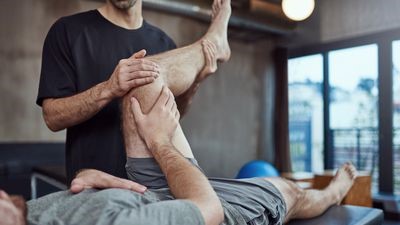Importance of Exercise After Joint Replacement Surgery
Hip and knee replacements can help many patients quickly return to an active life. From your preoperative physical condition to your adherence to postoperative guidelines, you are an important factor in determining the final outcome of surgery - the new hip or knee can not do it alone.
To get the most out of your new parts, you need to work on an exercise program. Work begins shortly after surgery with a personal rehabilitation plan subscribed by a physiotherapist. However, an important part of the recovery process begins when physiotherapy is completed. A lifelong commitment to exercise and a healthy lifestyle are important for continued joint improvement.

Strengthening and developing muscles around your new hip or knee is essential to keeping the joint in top shape. Your medical team will provide you with specific recommended exercises to help insure your success. If you're having difficulty staying active and progressing on your own, it may be necessary to partner with a physiotherapist or personal trainer for a longer period of recovery.
General physical fitness is also important, especially since most joint replacement patients have not been able to do enough activity due to pain in your knees and hips for some period of time before surgery. With a new joint and improving joint pain and stiffness, patients are able to engage in physical activity that will improve their overall health. Exercise has also been shown to improve balance and endurance following surgery, which can lower your risk of fall and subsequent injury.
RELATED ARTICLES:
Best Exercise After Joint Replacement
Exercise routines should include a combination of aerobic exercise, and movements specific for strength, flexibility, and balance. Walking and cycling programs alone are not enough. It is important to build a well-balanced exercise routine that will continue to improve mobility, conditioning, and balance.
The best news is that with your new hip or knee joint, most exercises and activities that you attempt will be easier than they have been in a very long time. The improved joint mobility and pain relief can be a powerful motivation following joint replacement surgery.

Aerobic Exercise
Aerobic exercise speeds up your heartbeat and produces a sweat. Try speeding-up your routine with walking, biking, or even elliptical or rowing machines. Alternating between different activities will produce a more balanced recovery. Always be cautious and put safety first. It is perfectly okay and recommended to use assistance devices such as walking poles as you return to an active lifestyle. It may take some time for balance, endurance, and strength to return to previous levels.
Once you have fully recovered from joint replacement, you should be able to perform almost all the activities you did before surgery. If you are considering participation in a high-impact or higher-risk activity, always consult your surgeon for their recommendation and guidance. Your surgeon will work with you to get you back to a healthy lifestyle while safe-guarding your new joint.
30 minutes a day of aerobic activity, 3-5 day a week is an appropriate goal and expectation.
Strength Training After Joint Replacement
Muscle mass and bone density decrease naturally with age and the process is made worse by chronic joint pain and decreased activity levels. To slow down these process, it is important to have a complete exercise routine that includes resistance training. Strength training muscles are the most effective strategy to build lean muscle mass, preserve bone density and improve hip and knee function.
Aim for participation in strength training exercises 2-3 times a week, and always try to include movements which help to develop flexibility and balance.
Find Exercise You Enjoy
Dr. Calendine emphasizes the importance of finding regular exercise opportunities that are convenient and that you enjoy. Whether dance, yoga, tai chi, or pool exercises, finding exercise routines and settings that bring you joy will often mean that you will participate more regularly. Movement is life and life is too short to be sedentary.
Consult Cory Calendine, MD, Orthopaedic Surgeon
Are you dealing with chronic or progressive hip or knee pain and unable to find relief. Dr. Calendine specializes in a full spectrum of nonsurgical and surgical joint arthritis treatments. Advances in surgical technology and joint implants means that most patients are able to spend less time in the hospital after joint replacement, return to activity sooner and be happier with their new hip or knee.
CONTACT our office today for an appointment with Dr. Calendine and the team at the Bone and Joint Institute of Tennessee.
When Should I Consider Joint Replacement? [Cory Calendine, MD]



.png)

.png)


